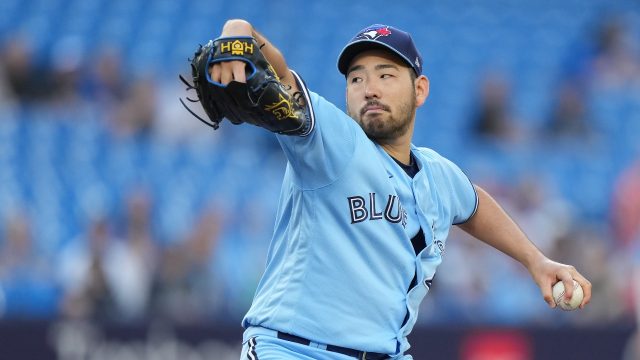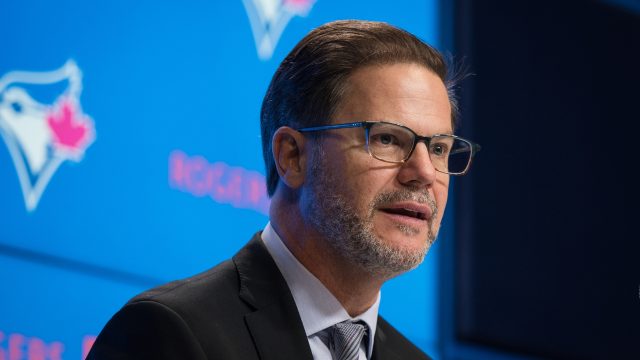
TORONTO – In an ideal world, the Blue Jays would have found a way to add another bat ahead of Tuesday’s trade deadline.
Having bolstered their bullpen with Jordan Hicks and added Paul DeJong as shortstop insurance alongside Bo Bichette, they continued to engage with other teams about bats in case there was a fit.
But though they discussed names such as Teoscar Hernandez (talks didn’t get serious, according to a source), Mark Canha (the Mets evidently preferred the Brewers’ offer) and Randal Grichuk (perhaps an awkward fit), the Blue Jays were never especially close to making another major deal as the 6 p.m. ET / 3 p.m. PT deadline drew nearer.
“Some of the players that were rumoured to be coming our way or even available didn’t seem to be as available to us,” GM Ross Atkins said after the deadline. “Most of the deals today that were available to us were smaller in nature and more roster management.”
All of which means the team with one of the best pitching staffs in the American League improved its run prevention more than its ability to score. (Although DeJong does have 13 homers, he’s here largely due to the glove that ranks, according to Baseball Savant, in the 97th percentile for outs above average.)
Now, a run saved is as good as a run scored, so there’s nothing wrong with improving your pitching and defence. But best-case scenario would have seen the Blue Jays improve on offence, too. With the deadline behind them, the Blue Jays will now need their existing players to step up if they’re going to improve offensively before the end of the year.
To be fair, that was probably always going to be the case. Even if they’d added a bat – take Pham, for instance – there’s no comparing the offence of one player to the potential impact that’s possible from the rest of the Blue Jays’ roster.
That’s especially true on a team with plenty of underperforming players. Consider how the following Blue Jays have fared in 2023 compared to their career numbers:
Vladimir Guerrero Jr.: career OPS+ entering 2023: 135; 2023 OPS+: 120; difference: -15
Cavan Biggio: – career OPS+ entering 2023: 104; 2023 OPS+: 88; difference: -16
Alejandro Kirk: – career OPS+ entering 2023: 123; 2023 OPS+: 97; difference: -26
Daulton Varsho: – career OPS+ entering 2023: 104; 2023 OPS+: 76; difference: -28
Santiago Espinal: – career OPS+ entering 2023: 102; 2023 OPS+: 70; difference: -32
George Springer: – career OPS+ entering 2023: 132; 2023 OPS+: 94; difference: -38
As the season has progressed, the likes of Guerrero, Biggio and Kirk have all hit better, closing the gaps between their established levels of performance and their 2023 numbers. Yet for others, it’s gone in the opposite direction.
Springer’s struggles are especially pronounced in the midst of an 0-for-34 stretch that’s seen his season OPS dip to .695. There have been positives lately, with three hard-hit balls against the Angels Sunday, but there have also been times that Springer’s been visibly frustrated at the plate and the results tell a similar story.
In Year 3 of a six-year, $150-million deal, the 33-year-old is centrally important to the Blue Jays’ chances. He doesn’t have to single-handedly drive their offence, but the Blue Jays will absolutely need more from their right fielder, among others.
In the minors, there’s support available with Davis Schneider (21 home runs, .982 OPS), Spencer Horwitz (7 home runs, .894 OPS) and Addison Barger (5 home runs, .736 OPS) all candidates to contribute at the big-league level down the stretch. While addressing the media following the trade deadline, Atkins suggested the Blue Jays are more likely to turn to their top triple-A bats than pursue a recently discarded player from a different organization.
“We like our internal options more than some of the DFA’d options,” Atkins said. “But we’ll obviously be open-minded and continue to do our work.”
Making that possibility more realistic, Horwitz and Barger are already on the 40-man roster, while Barger will have to be added this winter to protect him from the Rule 5 draft. Plus, as the minor league season comes to a close at the end of August, there are developmental advantages to be had by promoting a player to the majors.
Clearly, no one’s counting on those minor-leaguers to transform the Blue Jays’ offence. And, realistically, none of the deadline acquisitions were single-handedly going to do that, either. As much as another bat would have helped, there’s a bigger puzzle to solve here, and the solution will have to come from Blue Jays hitters as a collective.






